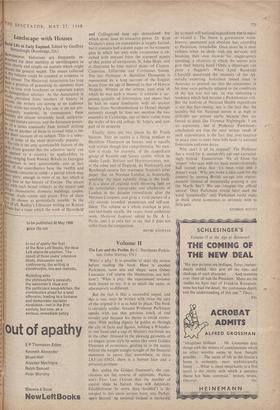Landscape with Houses
PROFESSIONAL historians are frequently re- proached for their inability or unwillingness to write Clearly and crisply on matters which might !merest the general reader. The essays collected 19 this volume could be counted as evidence in itleir favour. The Historical Association has long tiale a practice of presenting its members from euy. distinguished scholars. As the Association is Barraclough. (Routledge, 21s.) 10 time with brochures on important topics recruited from teachers of history in schools. the writers are aiming at an audience which, while not strictly a lay one, is yet not pre- dominantly academic. In consequence, these booklets are almost invariably lucid, authorita- 1lve and mature surveys, and the fortunate posses- tor'of a series constantly finds himself picking °ne or another of them to re-read what is the st short account of its subject. This is a selec- unn of some of the most deservedly popular. b The title is the only questionable feature of the book. Even granted that the adjective 'early' can 2 applied to a country, its applicability to essays ranging from Roman Britain to Georgian architecture is very questionable, and in fact r1.st of the contributors have the twelfth and 1,rteenth centuries in mind—a period which may rnl 'early' enough to most of us. but which is fled late in the history of Europe. The essays :1;1 with such broad subjects as the manor and ,,i,lage. monasteries, domestic buildings. castles, "'Illour, trade routes and prices. Five of them illay obe chosen as particularly notable In the rst f all dl ' Librarian wting on Roman Ition has a o topic s which the worrik of Haverfield tr B• , ey
and Collingwood long ago streamlined. but which never loses its evocative power. Dr. Rose Graham's piece on monasteries is largely factual, but it contains half a dozen pages on the monastic plan in which her own wide competence is en- riched with extracts from the scattered papers of that prince of antiquaries, St. John Hope. and is illustrated by four typical plans—of Cluniac. Cistercian. Gilbertine and Carthusian houses. The late Professor A. Hamilton Thompson is represented by a long account of the English house from the age of Beowulf to that of Horace Walpole. Written in the urbane. cool style of which he was such a master, it contains a sur• prising quantity of information and shows that he had an equal familiarity with all ancient houses from Northumberland to Dorset. though curiously enough he does not mention the two examples in Cambridge, one of them visible from the walks of his old college. St. John's, and now part of its property.
Finally. there are two pieces by Sir Frank Stenton. That on castles is a fitting pendant to Hamilton Thompson on houses. and is equally well written though less comprehensive. No men- tion is made, for example. of the magnificent group of Kentish and Sussex castles, which in- cludes Leeds. Bodiam and Hurstmonceaux, nor, at the other end of England, do Warkworth and Bamburgh receive fair treatment. Stenton's other paper, that on Norman London. is. historically speaking. the most valuable thing in the book. It is a piece of original work throwing light on the constitution, topography and inhabitants of London in the decades immediately after the Norman Conquest, and gives a vivid picture of a city already crowded, prosperous and self-con- fident. The volume as a whole overlaps in part. and inevitably recalls, the recent more ambitious work, Medieval England. edited by Dr. A. L. Poole, and it is only fair to say that it does not. suffer from the comparison.
DAVID KNOWLES






































 Previous page
Previous page